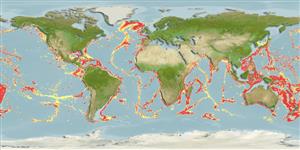>
Notacanthiformes (Halosaurs and deep-sea spiny eels) >
Halosauridae (Halosaurs)
Etymology: Aldrovandia: Taken from Ulisse Aldrovandi, (1522-1605), a Renaissance naturalist and physician noted by his systematic and accurate observations of plants and animals (Ref. 45335).
Eponymy: Dr Ulisse Aldrovandi (1522–1605) was an Italian naturalist. [...] (Ref. 128868), visit book page.
More on author: Günther.
Environment: milieu / climate zone / depth range / distribution range
Ecologia
marino benthopelagico; distribuzione batimetrica 730 - 2560 m (Ref. 3974). Deep-water
Circumglobal, tropical to temperate. Atlantic and Indo-Pacific, except Mediterranean.
Size / Peso / Age
Maturity: Lm ? range ? - ? cm
Max length : 60.0 cm TL maschio/sesso non determinato; (Ref. 41039)
Spine dorsali (totale) : 1; Raggi dorsali molli (totale) : 10 - 12. Body white to grey-brown in color, underside darker (Ref. 3974). Insertion of the pelvic fin only slightly anterior to the origin of the dorsal fin. Lacks scale on the opercle (Ref. 37108).
Occurs on the middle and lower slope primarily above the 4°C isotherm. Hovers within a few meters of substrate, parallel to it or inclined at varying angles (Ref. 6727). Feeds on polychaetes, pelecypods, amphipods and other benthic prey (Ref. 6727).
Life cycle and mating behavior
Maturità | Riproduzione | Deposizione | Uova | Fecundity | Larve
Sulak, K.J., 1990. Halosauridae. p. 126-132. In J.C. Quero, J.C. Hureau, C. Karrer, A. Post and L. Saldanha (eds.) Check-list of the fishes of the eastern tropical Atlantic (CLOFETA). JNICT, Lisbon; SEI, Paris; and UNESCO, Paris. Vol. 1. (Ref. 4448)
IUCN Red List Status (Ref. 130435: Version 2024-1)
Threat to humans
Harmless
Human uses
Strumenti
Special reports
Download XML
Fonti Internet
Estimates based on models
Preferred temperature (Ref.
123201): 2.5 - 6.6, mean 4 °C (based on 1890 cells).
Phylogenetic diversity index (Ref.
82804): PD
50 = 0.5156 [Uniqueness, from 0.5 = low to 2.0 = high].
Bayesian length-weight: a=0.00389 (0.00180 - 0.00842), b=3.12 (2.94 - 3.30), in cm total length, based on all LWR estimates for this body shape (Ref.
93245).
Trophic level (Ref.
69278): 3.3 ±0.40 se; based on food items.
Resilienza (Ref.
120179): Basso, tempo minimo di raddoppiamento della popolazione 4.5 - 14 anni (Assuming tmax>10).
Fishing Vulnerability (Ref.
59153): Moderate vulnerability (44 of 100).
Nutrients (Ref.
124155): Calcium = 10.7 [2.9, 38.3] mg/100g; Iron = 0.337 [0.111, 0.857] mg/100g; Protein = 1.6 [0.0, 5.5] %; Omega3 = 0.308 [0.115, 0.819] g/100g; Selenium = 20.5 [6.1, 75.9] μg/100g; VitaminA = 11.8 [2.3, 59.1] μg/100g; Zinc = 0.407 [0.209, 0.831] mg/100g (wet weight);
